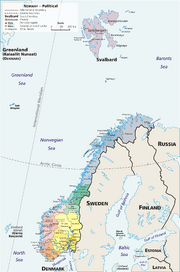
The Swedish flag.

Note Finnmark county's location on the Swedish, Finnish and Russian borders.
History[]
The Swedish Empire was a semi-colonial empire that held sway over most of the Baltic region during the 17th and early 18th centuries. With the Swedish involvement in the Thirty Years War, on the Reformist side, began an expansion of its territories and eventually the Swedish Empire was formed.
The Great Northern War of 1700–1721 was fought between the Tsardom of Russia and the Swedish Empire. At this time when Sweden was one of the great European powers and the Kingdom of Sweden's had my wars with the Principality of Moscow. Russia and then the USSR never forgot this historic fact.
Strong grassroots movements sprung up in Sweden during the latter (trade unions, temperance groups, and independent religious groups half of the 19th century, creating a strong foundation of democratic principles and the Swedish Social Democratic Party was founded in 1889. Famine victims fled the north for the south and abroad between the 1850-1910, with circa ~10,000,000 moving to the USA (especially Minnesota).
The last war in which Sweden was directly involved was in 1814, when Norway was militarily forced into personal union. Russia violently annexed present-day Finland off of Sweden in 1809.
There were 19th Century government-sponsored programmes of enclosure and the introduction of new crops such as the potato. Because the Swedish peasantry had never been en-serfed as elsewhere in Europe and a communist revolution was narrowly defeated in 1917.
They had almost got tangled up in the the Soviet Union invasion of Finland in November 1939, Sweden came to its neighbour's assistance in most other than openly declaring war on the USSR. A Swedish volunteer infantry brigade and a volunteer air squadron unofficially fought in northern Finland in January till March 1940. Sweden did not like communism and feared it's expatiation.
The location[]
About 15% of Sweden lies north of the Arctic Circle. The northern half has only a minimal population, most of who are on the various coastal towns and villages. The coast and south are flat and low-lying. The central and northern regions are hilly. Both the north and the west are major mountain ranges, which are highest in the north western border with Norway. The arable southern water is dominated by lakes Vänern (5519 km²) and Vättern (1886 km²). Most of the population, industries and urban zones are in or south of Stockholm.
The north to south temperatures differ greatly from north to south. Average temperatures expected in Sweden are heavily influenced by the large Fennoscandian landmass, continental Europe and western Russia, which allows hot or cool inland air to be easily transported to Sweden and thus renders most of Sweden's southern areas warmer than would be expected at that latitude.
Most of Sweden has a temperate climate, despite its northern latitude, with four distinct seasons and mild temperatures throughout the year. The southernmost part has an oceanic climate, the central part has a humid continental climate and the northernmost part has a subarctic climate. However, Sweden is much warmer and drier than other places at a similar latitude, and even somewhat farther south, mainly because of the Gulf Stream. In the capital, Stockholm, daylight lasts for more than 18 hours in late June but only around 6 hours in late December. Sweden receives between 1,100 and 1,900 hours of sunshine annually.
Mineral resources occlude nickel, uranium, strontium, iron, zinc, lead, stone, coal, oil shale, stone, sand, gravel, manganese, some oil, some potash, some gas and some bauxite. Timber is also largely available.
The issue[]

Saab_J_35A-01 fighter jets.

Tunnan jet 29670 "Gul Rudolf" in flight over Malmen.

A HKP4 helicopter during the "Swedish Battle Camp" in Stockholm.
Sweden knew it was weak and thus took to playing off both sides in the Second World War and feigning neutrality the Cold War. Sweden took a strange role in WW2 and sold iron ore to Germany with one hand whilst giving German V1 and V2 missile secrets to the UK with the other in a bid to stay independent. After the war they agreed to act as a NATO proxy and support it's intelligence community. They still could help their fellow Scandinavian nations in non-NATO/Warsaw Pact related affairs. The USSR and then Russia hated the pseudo-neutrality policy.
The Soviet submarine U 137 got stranded on a sand bank deep inside Swedish waters whist on secret manoeuvres on October 27, 1981.
The plan[]
Operation E.M.I.L., better known under its cover-name KRV (short for KRANVAGN, meaning mobile crane), was a secret tank development project that took place in Sweden during the early 1950s in order to replace the numerous types of by then out dated tanks they had with a new single or pair of superior Cold War era designs.
The Swedish Air Force fought as part of the United Nations peace-keeping mission ONUC during the Congo Crisis in 1961 to 1964. It's dozen or so semi-obsolete Saab 29 Tunnans performed well under the hot and often rugged conditions in tropical central Africa.
The going theory at the time was that the USSR was going to invade by sea from a conquered Denmark and/or conquered or willing Finland into the south and central regions of of Sweden. Malmö and Stockholm were the top targets.
- Uppsala and Stockhlom- Russia.
- Vizby- Poland\USSR.
- Kalmar- Poland\GDR\USSR.
- Malmö- GDR\Poland.
The Soviet submarine U 137 got stranded on a sand bank deep inside Swedish waters whist on secret manoeuvres on October 27, 1981.
The end of the Cold War saw the Swedish Armed Forces slashed as several air bases were deemed unnecessary and closed and fell from 400 fighters in 1994 to 150 in 2005. The fear of a mass Russian invasion is now less likely. With the ending of the Cold War, Sweden joined the enlarging European Union in 1996.
The Soviet's Operation Northern Norway was a plan to conquer and annex northern Norway and the Soviet invasion of Finland in an East/West war and this frightened Sweden. A few Polish and E. German units would eventual peculate out of a by the conquered Denmark and in to the southern tip of Norway and Sweden in time.
Sweden was invited in December 2006 to join the NATO Response Force, but they declined.

Invasion of southern Scandinavia.

The Soviet invasion of Denmark and southern Sweden.
.
The bunkers[]

Suorvajaure in stora sjofallet park.
Many nuclear bunkers were built, supplies hidden in fortified pseudo-houses, most rural sections of motorway being modified to act as emergency runways and several covert mountain forts were built in the western mountain during the 1960s and 1970s, but they had became redundant by the early 1980s. The best asset for any resistance war was the nation's rugged landscape and harsh weather.
The going theory at the time was that the USSR was gong to invade by sea from a conquered Soviet invasion of Denmark and/or conquered or willing Finland into the south and central regions of of Sweden. Malmo and Stockholm were the top targets.
Former nukes[]

Russian Navy Antonov An-26 Dvurekov-2.
During the final phase of World War II, the Swedish Government saw value in the future of nuclear energy, especially the Allied interest in Sweden’s uranium-containing black shale deposits. Sweden decided it should establish state run controls over its natural resources, including uranium in covert collaboration with the American and British governments, exclusive Swedish controls over uranium ore, and a ban on commercial mining of uranium. It also had some coal, iron ore and nickel, plus lesser amounts of other minerals in places.
After World War II, Sweden considered building nuclear weapons to defend themselves against a possible offensive assault from the Soviet Union in relation to any action in Norway and/or Finland. They had almost got tangled up in the the Soviet Union invasion of Finland in November 1939 and feared a repeat of this later on. From 1945 to 1972 the government ran a clandestine nuclear weapons program under the guise of civilian defence research at the Swedish Defence Research Agency (FOA). Some Soviet plans called for it's isolation behind a blockade, whilst others called for an all out assult and Sweden's eventual conquest by the USSR.
By the late 1950s the work had reached the point where underground testing was feasible. The option to continue development of weapons was abandoned in 1966, after about 10 years work. After Sweden's subsequent signing of the Non-Proliferation Treaty (NPT) in 1968 began the wind-down of the program, which finally concluded in 1972.
The Swedish Government sought to develop tactical nuclear weapons to be used against advancing Soviet forces and/or any militarily significant targets in in neighboring countries, in the event of war. All targets included places on the Baltic Sea such as the docks Riga in Latvia or enemy air bases like Chernyakhovsk air base in Russia's Kalliningrad Oblast. They wanted 19 or 20 of them for this purpose.
This is opposed to strategic nuclear weapons which are designed to be used against enemy cities, large factories and other larger-area targets to damage the enemy's ability to wage war and kill thousands of civilians in the proses.
Soviet agents that betrayed Sweden[]
- Stig Bergling- 1979.
- Stig Wennerström- 1964.
- Fritiof Enbom- 1951.
Also see[]

Scania in southern Sweden.
- Flygbassystem 60 and Flygbassystem 90
- Finnish pseudo-neutrality
- Operation Square Leg (1980) and Exercise Hard Rock (1982)
- Germany's Fulda Gap
- Seven days to the River Rhine (1979)
- French nuclear plans and the Force de Dissuasion
- The Swiss National Redoubt (1880-2010)
- North German Plain
- Operation Northern Norway
- The southern Danube route
- Soviet/NATO invasion of Finland
- The week of war policy
- Operation Gladio
- Nicaraguan Civil War
- Korean Demilitarized Zone
- Berlin Wall and Checkpoint Charlie
- Greece, Turkey and southern Italy
- Soviet invasion of Denmark
- Saab 29 Tunnan
- Operation E.M.I.L.
- Soviet submarine U 137
- 1951 Anglo-Irish air defence treaty
Links[]
- http://www.nato.int/docu/review/2007/issue3/english/history.html
- http://www.nato.int/nato_static_fl2014/assets/pdf/pdf_publications/NATO_member_and_partner_countries-2011-
- https://en.wikipedia.org/wiki/Kittil%C3%A4
- http://en.wikipedia.org/wiki/Swedish_nuclear_weapons_program
- http://coldwarsites.net/country/sweden/
- https://en.wikipedia.org/wiki/Sweden
- https://en.wikipedia.org/wiki/List_of_lakes_of_Sweden
- http://www.scb.se/statistik/_publikationer/OV0904_2012A01_BR_02_A01BR1201.pdf
- https://en.wikipedia.org/wiki/Sweden
- http://www.statistikdatabasen.scb.se/pxweb/en/ssd/START__BE__BE0101__BE0101Q/UtlSvBakgGrov/?rxid=86abd797-7854-4564-9150-c9b06ae3ab07c9b06ae3ab07